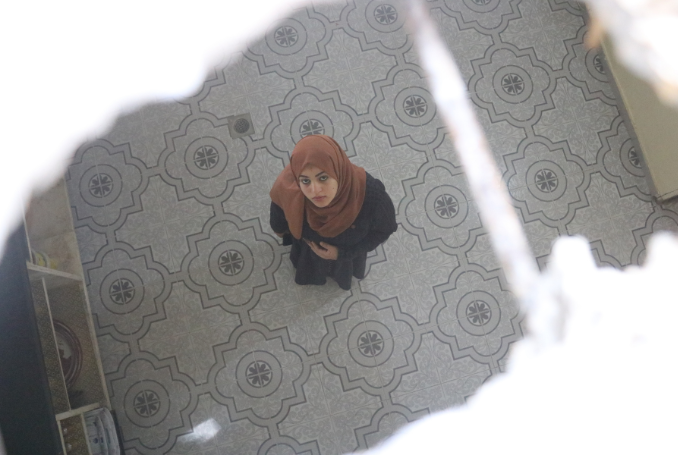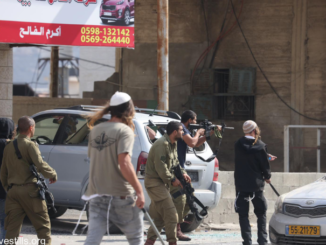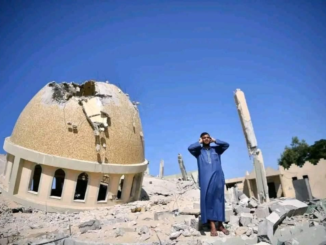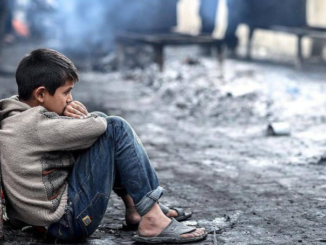
A few seconds later, shrapnel from a missile from the Iron Dome fell on their house, which is located in the eastern Khan Younis neighborhood of Abasan al-Saghira.
Yasmine al-Saqqa, 28, is an 8-month pregnant Palestinian woman who lives in Gaza. On May 14, the last day of the latest Israeli assault on the besieged Strip, she was in her kitchen, cooking lunch.
Her heart pounded every time she heard the frightening sounds of bombs and explosions caused by the Israeli Iron Dome, Tel Aviv’s air defense system designed to intercept rockets.
“I was terrified. I asked my husband, Jihad, to leave the house during the war but he refused and he kept telling me that it was safe,” Yasmine told Palestine Chronicle.
Suddenly, Yasmine heard the deafening sound of a blast. She started screaming and ran to Jihad who was in the living room.
A few seconds later, shrapnel from a missile from the Iron Dome fell on their house, which is located in the eastern Khan Younis neighborhood of Abasan al-Saghira, 700 meters away from the Israeli borders with the Strip.
“I saw white smoke in the kitchen. My body froze and I fell to the ground. I couldn’t even move a step,” Yasmine said.
After reaching his wife, Jihad carried Yasmine and they fled to their neighbor’s house, both taking shelter under the stairs.
Later, they returned to their home to find out what had happened.
“The shrapnel had made a hole in the kitchen roof,” Yasmine explained. “We took our clothes and some handbags with important family documents and some personal belongings and went to my family’s house in Khan Younis city center.”
Yasmine was distraught that she started feeling pain in her lower abdomen, so the couple rushed to the hospital to check on her baby’s safety.
“My baby was all that I cared about. Fortunately, everything was fine,” she said, with gratitude palpable in her voice.
On that same day, the Egyptian-brokered ceasefire ended the 5-day Israeli offensive, which killed 33 Palestinians, including six children and two women.
Yasmine and Jihad returned home the following day, but she was still afraid even after the ceasefire agreement was announced.
“I asked Jihad to sell the house and buy another one in a safer place, but unfortunately he can’t afford that now,” Yasmine said as her husband is a taxi driver and makes less than $15 a day.
Unexploded
Major Ahmed Othman, the director of the Technical Affairs Unit at the General Department of Explosive Ordnance Disposal at the Ministry of Interior and National Security in Gaza, told The Palestine Chronicle that the Iron Dome missile is designed to intercept rockets in the air.
“If it fails to intercept rockets, it explodes automatically,” Othman said. “When the explosion happens, the shrapnel often falls on the Gaza Strip causing damage to buildings and posing a threat to people.”
However, Othman noted that recently some of the rockets were not intercepted and did not explode.
During the latest assault, the Unit received 32 calls from people reporting Iron Dome shrapnel. Most of them were located in the northern governorate of Gaza.
The lack of necessary equipment, due to the hermetic Israeli blockade on Gaza, prevents the General Department of Explosive Ordnance Disposal from efficiently disposing of the shrapnel, according to Othman.
For example, until now they are not able to dispose of phosphorus bombs that were used by Israel in 2008, nor of scores of Israeli missiles that fell deep under the ground, posing a threat to people and the environment, especially to the Strip’s already limited water resources.
Palestinians in Gaza have appealed to the International Committee of the Red Cross and other international parties to come to the rescue.
They are hoping that these organizations could put some pressure on Israel to allow Gaza to import the equipment needed to dispose of the unexploded devices. So far, to no avail.

– Ahmed Al-Sammak is an experienced Gaza-based journalist whose writing has appeared in Middle East Eye, The Electronic Intifada, and others. WANN contributed this article to The Palestine Chronicle.







